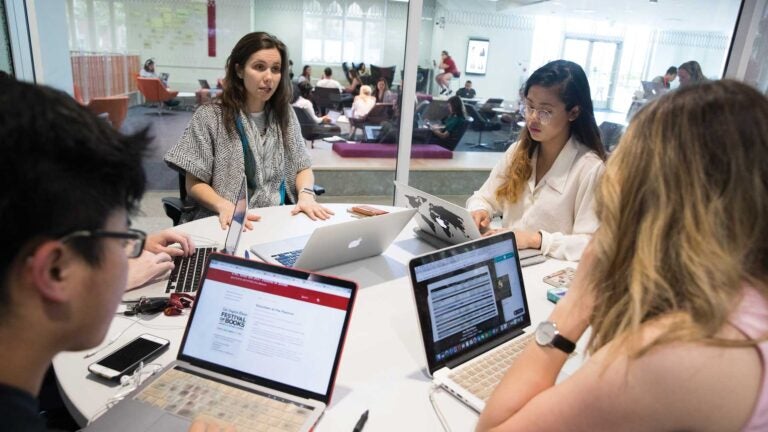
Laura Davis, back left, talks about new media with students. (Photo/John Davis)
USC Annenberg class focuses on creating news for people who have never read a newspaper
Why the next generation of news consumers — the “future audience,” as a USC professor puts it — has no attachment to the way news organizations have always worked
With the digital media revolution well underway, news organizations have invested a couple decades’ worth of innovation into their online presence. Longtime observers and news junkies have watched as website design advanced in leaps and bounds.
Young audiences, though, don’t quite see it that way.
The next generation of news consumers — or the “future audience,” as Laura E. Davis of the USC Annenberg School for Communication and Journalism puts it — has no attachment to the way news organizations have always done things. They have no allegiance to news produced for an old format like a print newspaper.
Davis has teamed up with lecturer Jenn de la Fuente to co-teach a directed research class that focuses on intense critical thinking about the news user experience. The class will culminate in the design of a journalism product along the lines of a “news concierge” app that strengthens the relationship between readers and journalists. The goal will be to foster a direct connection between readers and the editors who curate the app’s news, chat with readers, offer context and win their trust.
Student-run
As the app moves into the development stages, it will be deployed by the student-run Annenberg Media. The value is not only to bolster delivery of news but also to help students incorporate the user experience into the journalism they produce. If they’re involved in the day-to-day delivery of news and are responsible for it connecting with audiences, they are more likely to understand the stakes and be able to translate it into a sustainable skill in their careers as journalists.
“I think every journalist needs a little product-thinking to bleed through all of their work,” Davis said. “It’s really important for them to think about putting readers and users first.”
Davis was inspired to develop the class after reading research that shows readers actually lose trust in news sources that are difficult to use. When the news delivery is wonky — if it loads slowly, is blocked by ads or is cluttered — the audience ties that inefficiency to the journalism itself.
A younger audience doesn’t care what a newspaper looks like.
James Tyner
“A younger audience doesn’t care what a newspaper looks like,” said sophomore James Tyner, 19, whose post on Medium “Dear news media: Create news for people who have never read a newspaper” has been viewed more than 12,000 times.
“They never read them and never will. It’s not the way to go about presenting news if you’re trying to build something for the future.”
The next step
Enter Part 2 of Davis’ and de la Fuente’s class: product development.
Students are working to incorporate their critical thinking into a design experience that makes sense, and to make their app customizable. Students identified ways to make the tool feel like a personal news guide. With one overarching goal in mind: restoring trust.
“Laura and Jenn never say, ‘modify the old news model and make it newer,’” Tyner said. “It’s always, ‘How can we make something new?’ It’s always focused on the audience and user. Because for something to resonate with people, it has to be what they want rather than what the reporter wants.”
Turns out that’s exactly the theme Davis and de la Fuente want to leave to their students.
“I think it’s important that it comes from the students,” de la Fuente said. “We are arming them with the right tools and right way of thinking, and they can push the agenda forward.
“If a small crack has opened — maybe they can make a chasm and run through it.”
An extended version of this story appears on the USC Annenberg website.
